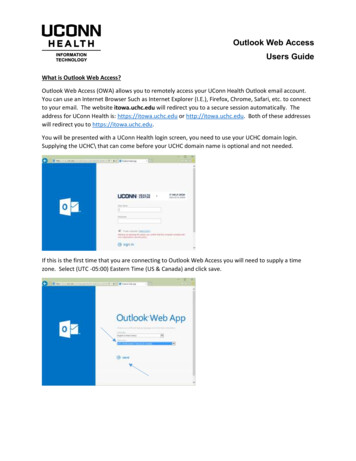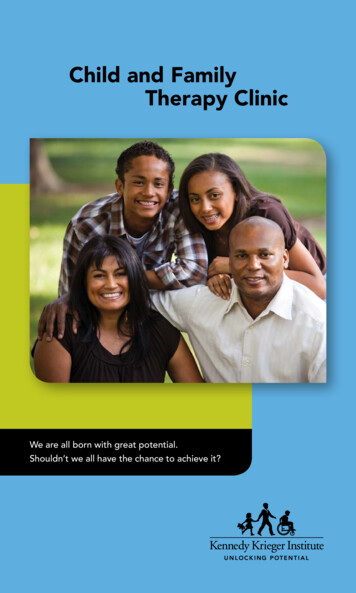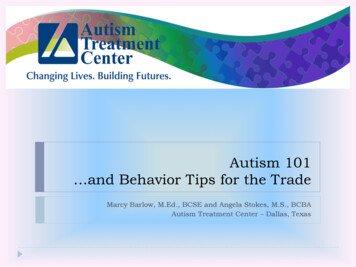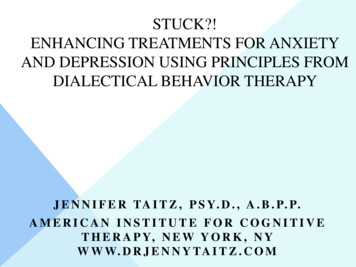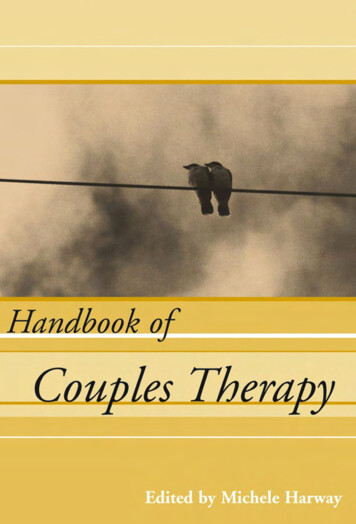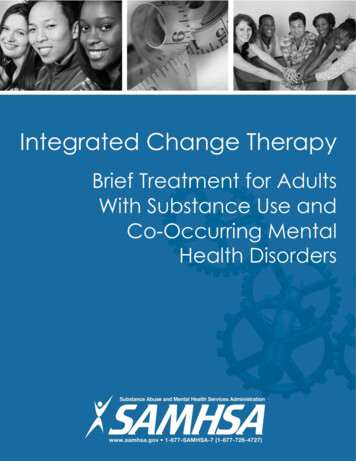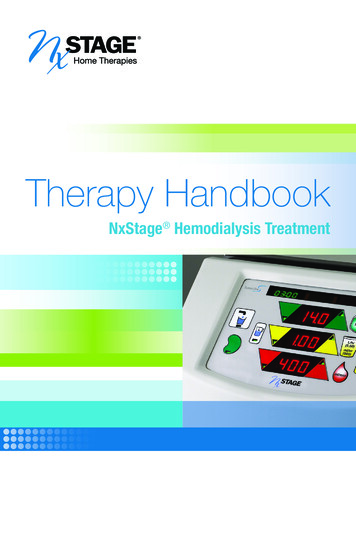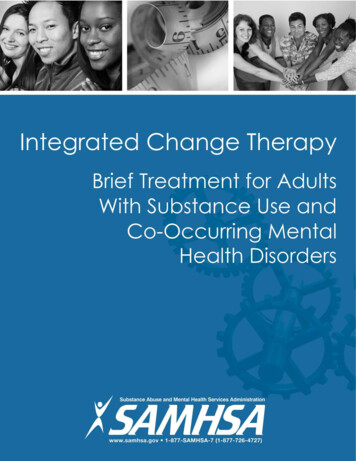
Transcription
Integrated Change Therapy1
Integrated Change TherapyBrief Treatment for Adults With Substance Useand Co-Occurring Mental Health DisordersIntegrated Change Therapyi
ContentsAuthors. viiiAcknowledgements. viiiIntroduction . 1Section 1. An Overview of Proven Tools and Techniques for Brief Treatment . 4Motivational Interviewing and Motivational Enhancement Therapy . 4The Personal Reflective Summary . 14Cognitive Behavioral Therapy . 17Treating Co-Occurring Disorders . 20Recovery Supports . 22Section 2. Clinician Guidance for 15 Sessions of Integrated Change Therapy . 24Introduction . 24Session 1. Rapport, Collaboration, and Personal Reflections. 27Session 2. The Change Plan and Supporter Involvement . 39Session 3. Making Important Life Decisions . 49Session 4. Enhancing Self-Awareness . 55Session 5. Handling Urges, Cravings, and Discomfort (Urge Surfing) . 65Session 6. Supporting Recovery Through Enhanced Social Supports and Activities . 76Session 7. Problem Solving . 81Session 8. Learning Assertiveness. 88Session 9. Mindfulness, Meditation, and Stepping Back . 96Session 10. Working With Thoughts . 104Session 11. Working With Emotions: Fostering Some, Dissolving Others . 112Session 12. The Next Chapter: Wellness Planning, Writing the Story . 122Session 13. Use of Medication in Support of Treatment and Recovery . 127Session 14. Engagement With Self-Help . 134Session 15. A MET/CBT Approach for Traumatic Stress and Substance Use . 137Section 3. Techniques and Tools Supporting Fidelity of Implementation and ClinicalSupervision . 145Introduction . 145ICT Clinician Checklist. 152Integrated Change Therapyii
Adherence and Competence Checklists . 155Integrated Change Therapy Session 1 . 156Integrated Change Therapy Session 2 . 157Integrated Change Therapy Session 3 . 158Integrated Change Therapy Session 4 . 159Integrated Change Therapy Session 5 . 160Integrated Change Therapy Session 6 . 161Integrated Change Therapy Session 7 . 162Integrated Change Therapy Session 8 . 163Integrated Change Therapy Session 9 . 164Integrated Change Therapy Session 10 . 165Integrated Change Therapy Session 11 . 166Integrated Change Therapy Session 12 . 167Integrated Change Therapy Session 13 . 168Integrated Change Therapy Session 14 . 169Integrated Change Therapy Session 15-1 . 170Integrated Change Therapy Session 15-2 . 171Integrated Change Therapy Session 15-3 . 172ICT Session 1. Rapport, Collaboration, and Personal Reflections Handouts . 173Clinician’s Quick Reference to Session 1 . 174Eight Questions Essential To Creating a Personalized Reflective Summary Report. 176A Bridge to Well-Being . 177Brief Treatment: Information Sheet . 181Learning New Coping Strategies in Support of Change . 182ICT Session 2. The Change Plan and Supporter Involvement Handouts . 184Clinician’s Quick Reference to Session 2 . 185Alcohol/Substance Use Awareness Record . 187Quit Agreement . 188A Change Plan . 189Planning To Feel Good . 190I Promise To Support . 191ICT Session 3. Making Important Life Decisions Handouts. 192Clinician’s Quick Reference to Session 3 . 193Integrated Change Therapyiii
MI Skills and Strategies . 195Readiness-To-Change Ruler . 196Decisionmaking Guide . 197Decisionmaking Guide Example . 199Thinking About My Use Option 3. 201ICT Session 4. Enhancing Self-Awareness Handouts . 202Clinician’s Quick Reference to Session 4 . 203Alcohol/Substance Use Awareness Record . 204Future Self Letter . 205Relaxation Practice Exercise . 206ICT Session 5. Handling Urges, Cravings, and Discomfort Handouts. 207Clinician’s Quick Reference to Session 5 . 208Coping With Cravings and Discomfort . 209Urge Surfing . 210Personal Awareness Form: What Happens Before and After I Use Alcohol andDrugs? . 211Personal Awareness Form Example: What Happens Before and After I Use Alcohol andDrugs? . 212Daily Record of Urges To Use. 213Learning New Coping Strategies . 214ICT Session 6. Supporting Recovery Through Enhanced Social Supports and ActivitiesHandouts . 216Clinician’s Quick Reference to Session 6 . 217Increasing Pleasant Activities. 219Engaging in Replacement Activities . 220Social Support . 221Plan for Seeking Support. 222ICT Session 7. Problem Solving Handouts . 223Clinician’s Quick Reference to Session 7 . 224Problem Solving . 225ICT Session 8. Learning Assertiveness Handouts . 226Clinician’s Quick Reference to Session 8 . 227Communication Styles . 228Integrated Change Therapyiv
Between-Session Challenge . 229ICT Session 9. Mindfulness, Meditation, and Stepping Back Handouts . 230Clinician’s Quick Reference to Session 9 . 231Mindfulness Meditation Instructions . 232Meditation Exercise: On the Riverbank . 233ICT Session 10. Working With Thoughts Handouts . 234Clinician’s Quick Reference to Session 10 . 235Managing Thoughts About Alcohol and Substances . 236ICT Session 11. Working With Emotions: Fostering Some, Dissolving Others Handouts . 238Clinician’s Quick Reference to Session 11 . 239Focus on Emotion: Roles of Positive and Negative Emotions . 240Focus on Emotion: Pleasant Activities . 241Cognitive Distortions That Dampen One’s Mood . 242Managing Negative Moods and Depression . 243Patient Health Questionnaire–9 (PHQ-9) . 244Generalized Anxiety Disorder 7-Item Scale (GAD-7) . 245ICT Session 12. The Next Chapter: Wellness Planning, Writing the Story Handouts . 246Clinician’s Quick Reference to Session 12 . 247Personal Care Plan: High-Risk Safety Planning . 248Personal Care Plan: Coping With a Lapse or Slip . 249My Story . 250ICT Session 13. Use of Medication in Support of Treatment and Recovery Handouts . 251Clinician’s Quick Reference to Session 13 . 252Medications To Treat Opioid Dependence . 253ICT Session 14. Engagement With Self-Help Handouts . 260Clinician’s Quick Reference to Session 14 . 261What Happens in an Alcoholics Anonymous Meeting?. 262ICT Session 15. A MET/CBT Approach for Traumatic Stress and Substance Use Handouts . 264Clinician’s Quick Reference to Session 15-1 . 265Clinician’s Quick Reference to Session 15-2 . 266Clinician’s Quick Reference to Session 15-3 . 267PTSD Checklist, Civilian Version (PCL-C) . 268PTSD CheckList, Military Version (PCL-M) . 271Integrated Change Therapyv
Primary Care PTSD Screen (PC-PTSD) . 273Sample Safety Plan. 274Deep-Breathing Relaxation . 276The Suicide Behaviors Questionnaire-Revised (SBQ-R) Overview. 278SBQ-R: The Suicide Behaviors Questionnaire, Revised. 280References . 281FiguresFigure 1. The Three Types of Helping Interactions . 5Figure 2. The Elements of Change . 6Figure 3. How a Patient Might Experience Ambivalence Toward Change . 7Figure 4. Personalized Reflective Discussions, Phase 1, Enhancing Motivation and Commitmentto Treatment . 15Figure 5. Phase 2, Using Functional Analysis To Identify Treatment Priorities and IndividualizeTreatment . 16Figure 6. Sample Therapy Sessions According to the Law of Thirds. 25Figure 7. A Supporter’s Guide To Helping a Partner or Friend Cope With a Slip . 48Figure 8. New Roads Worksheet. 62TableTable 1. ICT Clinical Interventions Addressing Substance Use and Mental Disorders . 22Integrated Change Therapyvi
AuthorsJBS International, Inc., under contract with the Substance Abuse and Mental Health ServicesAdministration’s (SAMHSA) Center for Substance Abuse Treatment (CSAT), prepared this guideon Integrated Change Therapy, incorporating works developed by grantees of SAMHSA’sScreening, Brief Intervention, and Referral to Treatment (SBIRT) program. These State granteesare from Connecticut, Massachusetts, and Missouri. Other works in brief treatment,motivational interviewing, and cognitive behavioral therapy have also been included. This guidewas authored by Win C. Turner, Ph.D., in Vermont and Missouri; Karen Steinberg Gallucci,Ph.D., in Connecticut; Lee Ellenberg, M.S.W., in Massachusetts; and Joseph Hyde, LMHC, SBIRTtechnical expert lead at JBS international, Inc.AcknowledgmentsThe authors thank Reed Forman, Program Area Lead, and Erich Kleinschmidt and Kellie Cosby,Government Project Officers for SBIRT initiatives supported by CSAT. Special thanks are alsoextended to those who contributed to and reviewed this guide, providing critical input andsharing generously their knowledge and expertise in service to the field and patients in need.James Bray, Ph.D., Kevin Corcoran, Ph.D., Janice Prochaska Ph.D., Daniel Vinson, M.D., andLinda Hurley, M.S., LCDP, LMHC, completed field reviews and provided valuable input to theguide. The authors also extend sincere thanks to the following individuals for theircontributions: Jody Kamon, Ph.D., Randy Muck, M.Ed., Thomas Babor, Ph.D., Ron Kadden,Ph.D., Susan Sampl, Ph.D., Cathleen Carroll, Ph.D., John Bush, M.D., Bruce Chorpita, Ph.D.,Bruce Horwitz, PH.D., Barbara Kean, Ed.D., Matthew Hile, Ph.D., Mary Dugan, Ph.D., EricDevine, Ph.D., and Michael Botticelli, M.A. CSAT’s Division of Services Improvement providedfunding for the development of this resource in support of CSAT’s enduring commitment to theadoption of evidence-based practices in community-based substance abuse and behavioralhealth treatment organizations. Finally, a special thank-you is extended to Michele Tilotta ofthe Iowa Department of Public Health and to SBIRT Iowa brief treatment clinicians for theirfeedback on ICT, and to the staff and soldiers of the Iowa National Guard for their dedicationand service to their State and country.The views, opinions, and content of this guide are those of the authors and do not necessarilyreflect the views, opinions, or policies of the Substance Abuse and Mental Health ServicesAdministration (SAMHSA), Center for Substance Abuse Treatment (CSAT). This guide was fundedby SAMHSA/CSAT and prepared by JBS International, Inc., under Contract NumberHHSS2832007000031/HHSS28300002T.Integrated Change Therapyvii
IntroductionThe brief treatment approach for substance abuse and co-occurring disorders described in thisguide—Integrated Change Therapy (ICT) for Substance Abuse and Co-Occurring Disorders—is anew clinical approach that draws essential elements of brief treatment from multiple sources.Specific innovations in this new practice are influenced by Screening, Brief Intervention, andReferral to Treatment (SBIRT) models, integrated with motivational interviewing (MI),motivational enhancement therapy (MET), functional analysis, and cognitive behavioral therapy(CBT).A primary goal in creating this guide is to respond to the needs of the working clinician intoday’s changing service delivery environment, with particular attention to behavioral healthclinicians practicing in primary care settings. Students in social work, psychology, andcounseling represent an important target audience, which is the next generation SAMSHA isseeking to reach. ICT’s approach enables ease of adoption of this new clinical practice withoutlarge changes to existing programs and systems. ICT is currently being practiced by cliniciansworking in community health centers, community-based substance abuse and mental healthagencies, and a program serving soldiers of the Army National Guard. The informationpresented here should serve as a relevant and practical resource for use on a daily basis toprovide individualized, patient-centered treatment.The knowledge and practices presented here for delivery of ICT are derived from several bodiesof work on evidence-based brief treatment for substance abuse and co-occurring mentaldisorders. These works include recent accomplishments in brief treatment by the University ofConnecticut Health Center as part of the Connecticut SBIRT initiative (LETSPAY), the BriefTreatment Manual developed by the Massachusetts SBIRT initiative, and the Brief TreatmentManual developed by the Missouri SBIRT team. Each of these three organizations, funded bythe Substance Abuse and Mental Health Services Administration (SAMHSA), developedevidence-based brief treatment manuals for adults with substance use disorders. Thesedocuments build on foundational works in CBT, MI, and other previous works in treatingaddictions, including the following:Beck, J., & Aaron, A. T. (2011). Cognitive behavior therapy: Basics and beyond. (2nd ed.). NewYork, NY: Guilford Press.Carroll, K. M. (1998). A cognitive-behavioral approach: Treating cocaine addiction. Manual 1:Therapy Manuals for Drug Addiction Series. NIH Publication No. 94–4308. Rockville, MD:National Institute on Drug Abuse.Marlatt, G. A., Barrett, K., & Daley, D. C. (1999). Relapse prevention. In M. Galanter & H. D.Kleber (Eds.), The American Psychiatric Press textbook of substance abuse treatment (2nd ed.).Washington, DC: American Psychiatric Press.Miller, W. R., & Rollnick, S. (2012). Motivational interviewing: Helping people change (3rd ed.).New York, NY: Guilford Press.Integrated Change Therapy1
Sampl, S., & Kadden, R., (2001). Motivational enhancement therapy and cognitive behavioraltherapy for adolescent cannabis users: Five Sessions. Cannabis Youth Treatment Series, Vol. 1.Rockville, MD: Substance Abuse and Mental Health Services Administration.Steinberg, K. L., Roffman, R. A., Carroll, K. M., McRee, B., Babor, T. F., Miller, M., . . . & Stephens,R. (2005). Brief counseling for marijuana dependence: A manual for treating adults. HHSPublication No. (SMA) 05-4022. Rockville, MD: Center for Substance Abuse Treatment,Substance Abuse and Mental Health Services Administration.The following features should help make this guide practical for use:1. Across many evidence-based practices, clinical researchers have identified a commonset of practice elements (Chorpita, Daleiden, & Weisz, 2005; Chorpita & Regan, 2009),and some have proposed that our health care system focus on training anddisseminating these essential skills and/or more universal clinical interventions (Barlow,2008). This guide is informed by such research.2. As a measure of utility for the behavioral health workforce, the guide’s coreinterventions are designed to fit within conventional models of service and can spandiverse practice settings, such as general outpatient services embedded within primarycare settings, including federally qualified health centers (FQHCs), and generaloutpatient substance abuse or mental health settings.3. In consideration of the high rate of staff turnover in the behavioral health workforce,this guide can serve as a model rooted in evidence-based clinical skills and interventionsthat are easily transferable from one setting to another. The clinical sessions are clearlylaid out without being overly prescriptive or restrictive. The interventions are flexibleenough to be integrated into clinicians’ personal styles and creativity.The guide is organized into three main sections. The first provides a review of MI, MET, CBT, thepersonal reflective summary as a treatment tool, and some of the newest thinking on theprocesses of therapy. The second section describes 15 clinical sessions. Some sessions focus onengagement, building motivation, clarifying treatment priorities for the patient, and developinga patient-clinician agreement. Other sessions address skills training, effective and healthyreplacement activities, building personal awareness, developing specific skills to managecravings and urges to use substances, and managing distressing thoughts and emotions. Twosessions cover known beneficial strategies equally useful with all treatment approaches: (1) useof medications in support of treatment and recovery, and (2) engagement with self-help. Theformat of each session in this guide facilitates delivery of ICT according to a commonframework, while at the same time tailoring delivery of selected sessions to a patient’sindividual needs.The third section of the Guide provides a discussion of techniques and tools that supportadoption and sustained implementation of interventions with a focus on enhancing fidelity. Thetechniques include a discussion of proven strategies for enhancing clinical supervision toincrease competency in essential clinical skills. The tools will help clinicians learn andunderstand delivery of each session, facilitate specific session feedback, and reduce paperworkIntegrated Change Therapy2
burdens. Session handouts and forms, other supporting materials, and references appear at theend of the guide.Users of this guide are encouraged to first read it through and then use the session outlines andfidelity tools to support delivery of the interventions. Worksheets, handouts, and other supportmaterials appear in corresponding sections at the end of the guide and may be copied and usedas needed in sessions. Live and online trainings are available and recommended.Integrated Change Therapy3
Section 1. An Overview of Proven Toolsand Techniques for Brief TreatmentCurrent approaches to understanding the treatment of substance use and co-occurringdisorders are driven by empirical advances in neuroscience and behavioral research rather thanby theories alone. There is now good evidence that both biological factors and psychosocialexperiences influence the development and continuation of disorders. Contributing experiencesmay occur at home, at work, or in the community, and a stressor or risk factor may have a smallor profound effect, depending on individual differences. The following review of motivationalinterviewing (MI), motivational enhancement therapy (MET), personal reflective summary(PRS), and cognitive behavioral therapy (CBT) provides context for the treatment sessions andmethodology described later in this guide.Motivational Interviewing and Motivational Enhancement TherapyMI is an effective, evidence-based method for helping patients with a variety of health andbehavioral concerns. Motivational approaches, as developed by William Miller and StephenRollnick (2012), seek to foster the intrinsic drive people have for healing, positive change, andself-development. Since Miller and Rollnick’s original work was published in 1983, more than25,000 articles citing MI and 200 randomized clinical trials of MI have appeared in print. MI’sefficacy has been substantiated by several MI training research projects (Miller, Yahne, Moyers,Martinez, & Pirritano, 2004).MET is a structured intervention approach that uses MI techniques. MET interventions typicallyinvolve both a specific feedback discussion following screening and/or assessment and goalsetting interactions (planning). The descriptions of MET sessions in this guide include scriptsillustrating the effective use of MI techniques.Integrating motivational enhancement and cognitive behavioral skills building to elicitchange—how it works: Motivation enhancement is achieved by building rapport through reflectivediscussions, helping patients understand the pros and cons of use, and helping toestablish collaborative goals based on the patient’s needs. Motivational enhancement strategies assess and increase the pat
on Integrated Change Therapy, incorporating works developed by grantees of SAMHSA’s Screening, Brief Intervention, and Referral to Treatment (SBIRT) program. These State grantees are from Connecticut, Massachusetts, and Missouri. Other works in brief treatment, motivational interviewing, and cognitive beh
